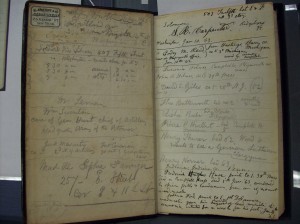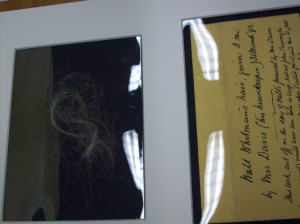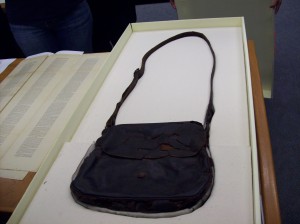I am indebted to Other Sam for drawing my attention to this very moving detail. One of the best things I saw at the Library of Congress was Whitman’s letter of December 29, 1862 (that is, exactly 106 years before the day I was born), to his mother about finding George in Fredericksburg. We were able to read aloud his words about the suffering of the soldiers putting other suffering into perspective. We have read this letter in a collected of selected letters: “Dear, dear Mother, . . . I succeeded in reaching the 51st New York, and found George alive and well–in order to make sure that you would get the good news, I sent back by messenger to Washington (I dare say you did not get it for some time), a telegraphic dispatch . . .” What is not visible in that version of the letter is the revision Whitman made, no doubt anticipating the anxiety with which his mother would scan the letter if she had not received the “telegraphic dispatch” or was desperate for information about her wounded son. Lovely:
Tag-Archive for » manuscripts «
Immediacy is something the Reverend talks about as a benefit of the blog, social networking technologies, and the great digital experiment that is Looking for Whitman. Presence. Accessibility. These are words we use a lot. So this week a question has been dogging me while I process Digital Whitman’s Saturday field trip to Washington City. This pair of images sets it up:
WW notebook #94, Library of Congress American Memory site
The one on top is from a link to the Library of Congress I gave the class a few weeks ago, urging them to use these digitized images to study what OMW recorded about the soldiers. The bottom was taken on our field trip, and is surprisingly focused given that I, Brady Earnhart, and our students were nearly all literally in tears in that weird institutional room with lockers, blackened windows, and government-issue tables. Unless we were crying with simple gratitude for the incredible time that Barbara Bair had given us (or because we were soaked to the bloody skin and had been standing for 10 hours with two or three to go), why were we? Nothing was much easier to read in person, as those of us who stumbled reading aloud can attest (writing still spidery, bleeding through paper, plastic protection on many items reflected flourescent glare, etc.). We couldn’t touch anything (though, good lord, we certainly breathed all over it), couldn’t feel the paper, the wood, the leather, the hair (the hair!).
I couldn’t even smell the leather of that haversack or of its decay, and I have one good super-sniffer.
Obviously, what I am suggesting is this: the artifacts of the Library of Congress archive were in some ways no more accessible or immediate (indeed, let’s be honest, a lot LESS accessible or even immediate if we mean time instead of proximity) than the digitized images of those artifacts online. I saw that the inside of the haversack is brown canvas. Brendon found a fingerprint and will NOT entertain suggestions that it belongs to anyone but Walt Whitman. But tears?
Presence. Through the blog we are present to each other online even when we are physically apart during the week (or have never seen each other: hallooo out there, Brooklyn, Camden, and Novi Sad!). Agreed. But finally Saturday we were (good) old-fashioned groupies, we were Whitman lovers, and we were bodies (finer than prayer, but, geez, we were a bit rank by Hour Ten of the marathon). We desired the physical–the textured, the pasted, the water-stained. We may have cried because the broken skins of brittle pages and fragile covers, the light-sensitive [associative digression: Whitman’s Camden eyeglasses: so small, and with one lens protectively glazed over after strokes] and subsequently entombed haversack, and the tickets to a lecture on Lincoln long since delivered were as close to Whitman (brittle, entombed…) as we are going to get, as present as we can be. Unlike the wounded soldiers, we won’t get the healing presence of his 200-pound, hirsute, maroon-coated, deep-pocketed self. But it turns out that the digitized can’t hold a gas lamp to the physically present, and even if it’s paper and not flesh, I’ll take it. Whitmaniacs, pass the tissues.
Whitmaniacs, go HERE NOW for a Library of Congress link for schoolteachers that has digitized images of some of Whitman’s notebooks, including from the Civil War (and a wrenching photo of a dead confederate solider in Spotsylvania). Don’t just look, READ: their names, their mother’s names, their ages, where they worked, where they’re from, which had been at Pfaff’s, their wounds and injuries (including overdosing), what they need from him (a clergyman, something to read), their qualities (somewhat “feminine”; “tall, well-tann’d,” an “oily, labial” way of speaking; “noble, beloved”); their battle stories.
Hey Whitmaniacs, here’s a shiver-inducer:
Today I was in C’ville for an appointment and when it was done, my traveling companion Professor Emerson and I decided to stretch our legs on the grounds of our alma mater. Professor Emerson has a friend who works in the new rare book facility, which I had not seen, and we stopped by to see him. Although we missed him for the day, we paused to look in a small display on the edge of the controlled rare book area. And (hold your slouch hats), I suddenly recognized the handwriting on two pieces of paper, each about 3×5 (one with ragged edges as though torn out): a hand-written manuscript of “When I Heard at the Close of Day,” in ink with WW’s revisions in pencil (description in the display: “autograph manuscript with pencilled and pasted corrections in author’s hand. 1857-1859”), the final lines of the poem squeezed near the bottom of the second page. Needless to say, I nearly shrieked, but instead read the poem aloud to Professor Emerson, who bravely offered to risk jail by using her cell phone as a camera in the controlled rare book space. Though I was perfectly willing to risk her freedom in pursuit of Walt, we both felt the manuscript would not photograph through the specialized glass, so instead you have only this, my testimonio, and will have to trust me that it was wonderful.




